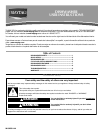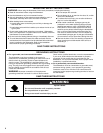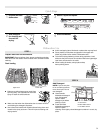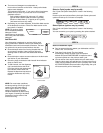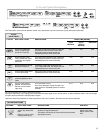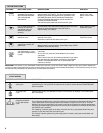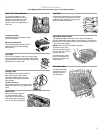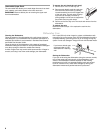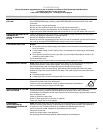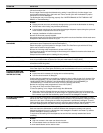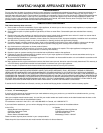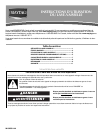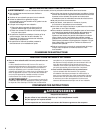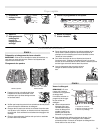
9
Troubleshooting
First try the solutions suggested here or visit our website and reference FAQs (Frequently Asked Questions)
to possibly avoid the cost of a service call.
In the U.S.A., www.maytag.com In Canada, www.maytag.ca
PROBLEM SOLUTION
DISHWASHER DOES
NOT RUN
NOTE: It is normal for the dishwasher to repeatedly pause several times during a cycle.
If the START/RESUME light is blinking, press START/RESUME and close the door firmly within
3 seconds.
Be sure the door is closed and latched.
Be sure you have selected a cycle. (See “Cycle and Option Descriptions.”)
Be sure there is power to the dishwasher. A circuit breaker or fuse may have tripped.
If lights other than START/RESUME blink and the unit will not run, you will need to call for service.
DETERGENT REMAINS IN THE
DISPENSER OR
TABLET IS ON BOTTOM
OF TUB
Check for dishware such as cookie sheets, cutting boards, or large containers, etc. that may be
blocking the detergent dispenser from opening properly.
Be sure your detergent is fresh and lump free.
Be sure the cycle has completed (green light is on). If it has not completed, you will need to resume
the cycle by pressing START/RESUME and closing the door within 3 seconds.
CYCLE RUNS TOO LONG NOTES:
■ To use less water and reduce energy consumption you will encounter cycles that typically run
for up to 3 hours.
■ A water heater setting of 120°F (49ºC) is best. The dishwasher will delay longer while heating
cooler water.
■ Some options will add time to the cycle. (See “Cycle and Option Descriptions” section.) The
Heated Dry option adds ½ hour.
Try the Insta Wash cycle.
Run the hot water at a faucet close to the dishwasher before starting the cycle.
DISHWASHER NOT DRYING NOTE: Plastic and items with nonstick surfaces are difficult to dry because they have a porous
surface which tends to collect water droplets. Towel drying may be necessary.
Use of rinse aid along with the Heated Dry option is needed for proper drying.
Proper loading of items can affect drying. (See specific loading instructions within this guide.)
Glasses and cups with concave bottoms hold water. This water may spill onto other items when
unloading.
■ Unload the bottom rack first.
■ Locate these items on the more slanted side of the rack for improved results.
WILL NOT FILL Be sure the water is turned on to the dishwasher.
Check that the float is free from obstructions.
Check for suds in the dishwasher. If foam or suds are detected, the dishwasher
may not operate properly or may not fill with water.
WATER REMAINS IN THE TUB/
WILL NOT DRAIN
Be sure the cycle has completed (the green light is on). If the cycle has not completed, you will need
to resume the cycle by pressing START/RESUME and closing the door within 3 seconds.
If dishwasher is connected to a food waste disposer, be sure the knockout plug has been removed
from the disposer inlet.
Check for kinks in the drain hose.
Check for food obstructions in the drain or disposer.
Check your house fuse or circuit breaker.
HARD WATER
(WHITE RESIDUE ON
DISHWASHER INTERIOR OR
GLASSWARE)
NOTE: Extremely hard water mineral deposits can cause damage to your dishwasher and make it
difficult to achieve good cleaning. A water softener is strongly recommended if your hardness is
15 grains or more. If a water softener is not installed, the following steps may help:
Use a commercial cleaner designed for dishwashers once per month.
Always use a rinse aid.
Always use a high-quality, fresh detergent.
Use a detergent booster/water softener additive designed for dishwashers.



